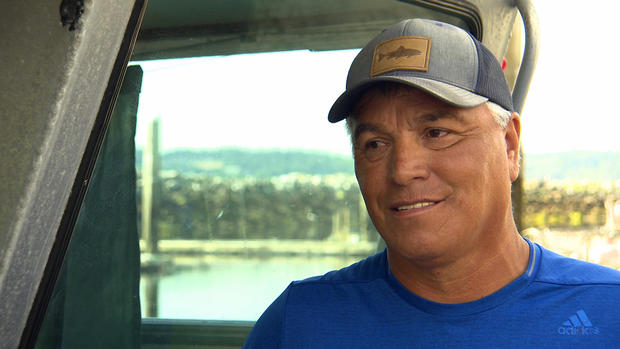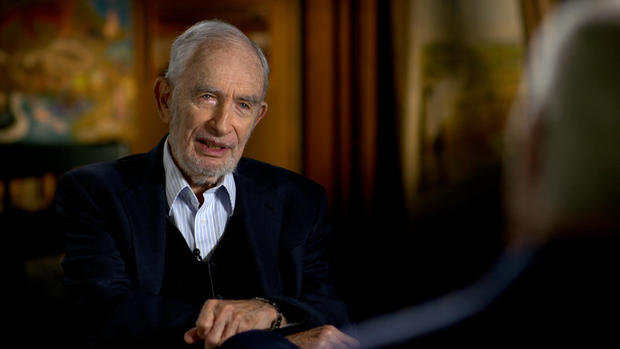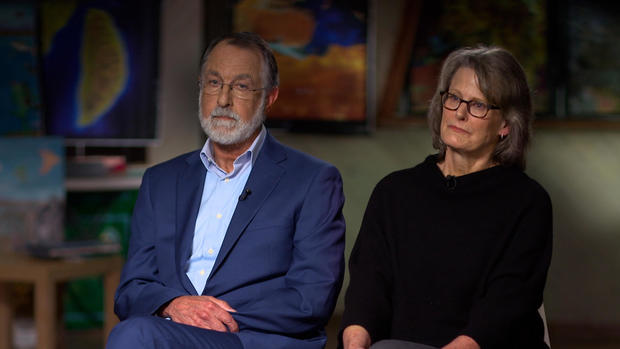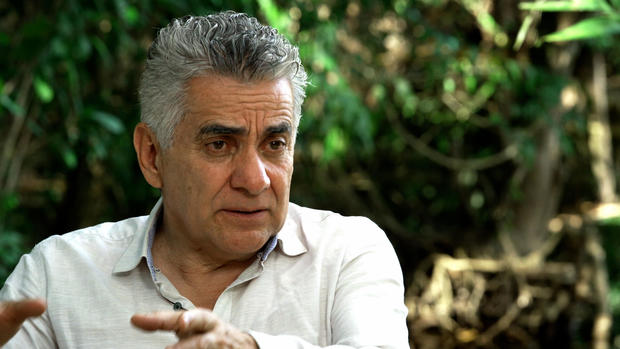“Scientists say planet in midst of sixth mass extinction, Earth’s wildlife running out of places to live”, 60 Minutes
By Scott Pelley, CBS News, January 1, 2023
In what year will the human population grow too large for the Earth to sustain? The answer is about 1970, according to research by the World Wildlife Fund. In 1970, the planet’s 3 and a half billion people were sustainable. But on this New Year’s Day, the population is 8 billion. Today, wild plants and animals are running out of places to live. The scientists you’re about to meet say the Earth is suffering a crisis of mass extinction on a scale unseen since the dinosaurs. We’re going to show you a possible solution, but first, have a look at how humanity is already suffering from the vanishing wild.
In Washington state, the Salish Sea helped feed the world.
Dana Wilson: With this weather and the way things feel once I get out here, it’s time to be fishing, that’s what it feels like.
Commercial fisherman Dana Wilson supported a family on the Salish Sea’s legendary wealth of salmon. He remembers propellers churning the water off blaine, washington and cranes straining for the state’s 200 million dollar annual catch.
Dana Wilson: That used to be a buying station, they’re gone now, they don’t buy anymore. So, that building over there used to buy salmon, they don’t buy salmon anymore, it’s just not here.
In 1991, one salmon species was endangered. Today, 14 salmon populations are foundering. They’ve been crowded out of rivers by habitat destruction, warming, and pollution. Dana Wilson used to fish all summer. Today, a conservation authority grants rare, fleeting, permission to throw a net.
Scott Pelley: There was a season.
Dana Wilson: There was a season.
Scott Pelley: Now there’s a day?
Dana Wilson: There’s a day, and sometimes it’s hours. Sometimes you might get 12 hours, 16 hours. that’s what we’re down to.
Here, the vanishing wild scuttled a way of life that began with native tribes a 1,000 years ago.
Armando Brionez: I don’t remember anybody doing anything other than salmon fishing.
Fisherman Armando Brionez is a member of the Lummi Tribe, which calls itself “people of the salmon.” He didn’t imagine the rich harvest would end with his five fishing boats.
Armando Brionez: All of a sudden, you’re trying to figure out, “Well, how am I gonna make that paycheck for my family?” Well for me it was like well, I have a backup for a backup, for a backup, for a backup.
Brionez’s ‘backups’ include his new food truck, switching to crab fishing, and consulting on cannabis farms. His scramble to adapt is being repeated around the world. A World Wildlife Fund study says that in the past 50 years, the abundance of global wildlife has collapsed 69%, mostly for the same reason.
Paul Ehrlich: Too many people, too much consumption and growth mania.
At the age of 90, biologist Paul Ehrlich may have lived long enough to see some of his dire prophecies come true.
Scott Pelley: You seem to be saying that humanity is not sustainable?
Paul Ehrlich: Oh, humanity is not sustainable. To maintain our lifestyle (yours and mine, basically) for the entire planet, you’d need five more Earths. Not clear where they’re gonna come from.
Scott Pelley: Just in terms of the resources that would be required?
Paul Ehrlich: Resources that would be required, the systems that support our lives, which of course are the biodiversity that we’re wiping out. Humanity is very busily sitting on a limb that we’re sawing off.
In 1968, Ehrlich, a biology professor at Stanford, became a doomsday celebrity with a bestseller forecasting the collapse of nature.
Scott Pelley: When “The Population Bomb” came out, you were described as an alarmist.
Paul Ehrlich: I was alarmed. I am still alarmed. All of my colleagues are alarmed.
The alarm Ehrlich sounded in ’68 warned that overpopulation would trigger widespread famine. He was wrong about that. The green revolution fed the world. But he also wrote in ’68 that heat from greenhouse gases would melt polar ice and humanity would overwhelm the wild. Today, humans have taken over 70% of the planet’s land and 70% of the freshwater.
Paul Ehrlich: The rate of extinction is extraordinarily high now and getting higher all the time.
We know the rate of extinction is ‘extraordinarily high’ because of a study of the fossil record by biologist Tony Barnosky, Ehrlich’s Stanford colleague.
Tony Barnosky: The data are rock solid. I don’t think you’ll find a scientist that will say we’re not in an extinction crisis.
Barnosky’s research suggests today’s rate of extinction is up to 100 times faster than is typical in the nearly 4 billion year history of life. These peaks represent the few times that life collapsed globally. And the last was the dinosaurs, 66 million years ago.
Tony Barnosky: There are five times in Earth’s history where we had mass extinctions. And by mass extinctions, I mean at least 75%, three quarters of the known species disappearing from the face of the Earth. Now we’re witnessing what a lot of people are calling the sixth mass extinction where the same thing could happen on our watch.
Liz Hadly: it’s a horrific state of the planet when common species, the ubiquitous species that we’re familiar with are declining.
Tony Barnosky’s colleague in the study of extinction is his wife, biologist Liz Hadly, faculty director at Stanford’s Jasper Ridge Research Preserve in California.
Liz Hadly: You know, I see it in my mind and it’s a really sad state. If you’ve spent any time in California, you know the loss of water. The loss of water means that there are dead salmon you see in the river right before your eyes. But it also means the demise of those birds that rely on the salmon fishery, eagles. It means, you know, things like minks and otters that rely on fish. It means that our habitats that we’re used to, the forests that– you know, 3,000-year-old forests are going to be gone. So it means silence. And it means some very catastrophic events because it’s happening so quickly.
Tony Barnosky: It means you look out your window, and three quarters of what you think ought to be there is no longer there. That’s what mass extinction looks like.
Liz Hadly: What we see just in California is, you know, the loss of our iconic state symbols. We have no more grizzly bears in California.
Scott Pelley: The only grizzly bears in California are on the state flag?
Tony Barnosky: that’s our state mammal and they are not here anymore.
Scott Pelley: Is it too much to say that we’re killing the planet?
Liz Hadly: No.
Tony Barnosky: I would say it is too much to say that we’re killing the planet, because the planet’s gonna be fine. What we’re doing is we’re killing our way of life.
The worst of the killing is in Latin America where the World Wildlife Fund study says the abundance of wildlife has fallen 94% since 1970. But it was also in Latin America that we found the possibility of hope.
Mexican ecologist Gerardo Ceballos is one of the world’s leading scientists on extinction. He told us the only solution is to save the one third of the Earth that remains wild. To prove it, he’s running a 3,000-square-mile experiment. In the Calakmul Biosphere Reserve near Guatemala, he is paying family farmers to stop cutting the forest.
Gerardo Ceballos: We’re going to pay each family certain amount of money that is more than you will get cutting down the forest, if you protect it
Scott Pelley: And how much are you paying out every year?
Gerardo Ceballos: For instance, each family here will get around $1,000.
More than enough, here, to make up for lost farmland. In total, the payouts come to $1.5 million a year. Or about $2,000 per square mile. The tab is paid through the charity of wealthy donors.
Gerardo Ceballos: the investment to protect what is left is, I mean, really small
The payoff on that investment is being collected on Ceballos’ jungle cameras. Thirty years ago the jaguar was very nearly extinct in Mexico. Now Ceballos says they’ve rebounded to about 600 in the reserve.
Scott Pelley: There are other places where there are reserves around the world where they’ve been able to increase the populations of certain species. But I wonder, are all these little success stories enough to prevent mass extinction?
Gerardo Ceballos: All the big success that we have in protecting forests and recovering animals, like tigers in India, jaguars in Mexico, elephants in Botswana, and so on, are incredible, amazing, successes. But they are like grains of sand in a beach. And to really make a big impact we need to scale up this 10,000 times. So, they are important because they give us hope. But they are completely insufficient to cope with climate change.
Scott Pelley: So what would the world have to do?
Gerardo Ceballos: What we will have to do is to really understand that the climate change and the species extinction is a threat to humanity. And then put all the machinery of society: political, economic, and social, towards finding solutions to the problems.
Finding solutions to the problems was the goal, two weeks ago, at the U.N. Biodiversity Conference, where nations agreed to conservation targets. But at the same meeting in 2010, those nations agreed to limit the destruction of the Earth by 2020—and not one of those goals was met. This, despite thousands of studies including the continuing research of Stanford biologist Paul Ehrlich.
Scott Pelley: You know that there is no political will to do any of the things that you’re recommending.
Paul Ehrlich: I know there’s no political will to do any of the things that I’m concerned with, which is exactly why I and the vast majority of my colleagues think we’ve had it; that the next few decades will be the end of the kind of civilization we’re used to.
In the 50 years since Ehrlich’s population bomb, humanity’s feasting on resources has tripled. We’re already consuming 175% of what the Earth can regenerate. And, consider, half of humanity, about four billion, live on less than $10 a day. They aspire to cars, air conditioning and a rich diet. But they won’t be fed by the fishermen of Washington’s Salish Sea, including Armando Brionez.
Scott Pelley: The tribe has been fishing salmon here for hundreds of years?
Armando Brionez: Yeah.
Scott Pelley: And your generation is seeing the end of that?
Armando Brionez: It’s getting harder and harder. I hate to say– I don’t wanna say it’s the end of it.
Scott Pelley: why do you feel so emotionally attached to this?
Armando Brionez: It’s everything we know. I’m fortunate enough to know where I know a lot of different things. I’ve done a lotta different things in my life. I’ve gotten good at evolving and changing. But not everybody here is built like that. To some of us this is what they know, this is all they know.
The five mass extinctions of the ancient past were caused by natural calamities—volcanoes, and an asteroid. Today, if the science is right, humanity may have to survive a sixth mass extinction in a world of its own making.
Produced by Maria Gavrilovic. Associate producer, Alex Ortiz. Broadcast associate, Michelle Karim. Edited by April Wilson.




